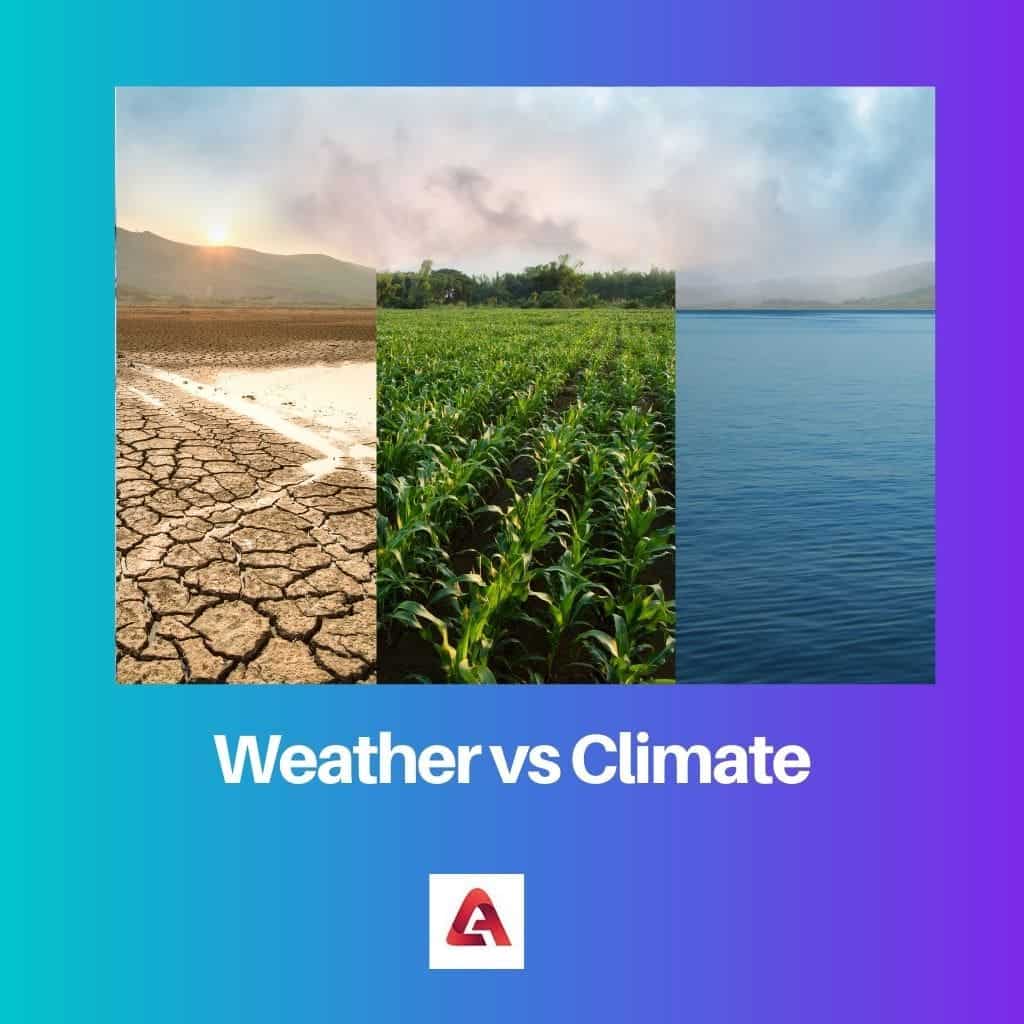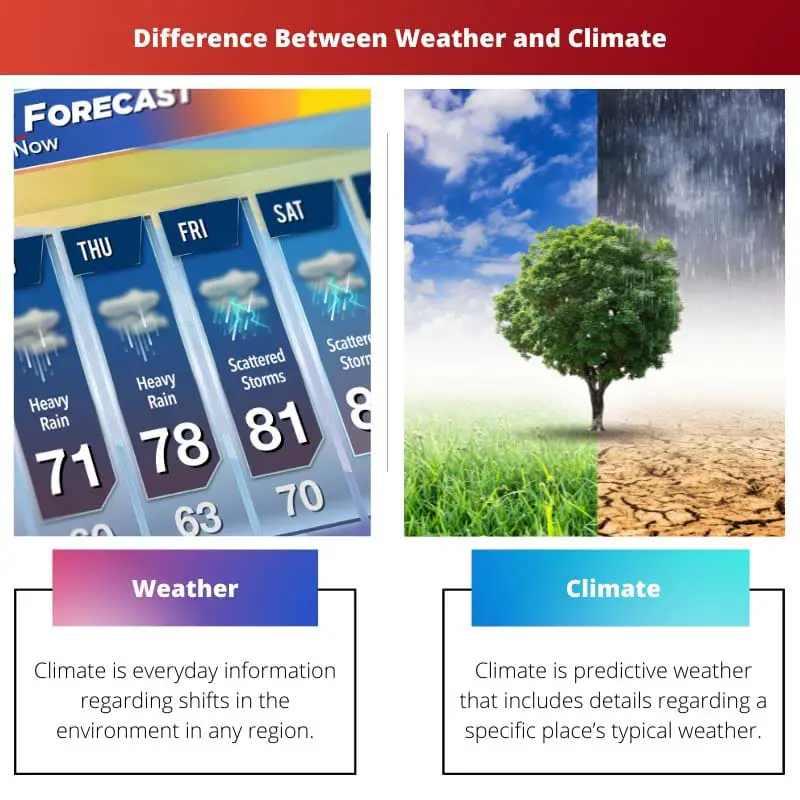Weather is the short-term atmospheric conditions at a specific time and place, while climate refers to long-term patterns of temperature, precipitation, and other atmospheric phenomena over a larger region.
Key Takeaways
- Weather describes short-term atmospheric conditions, while climate represents long-term patterns and averages.
- Weather can change rapidly, whereas climate changes occur gradually over decades or longer.
- The climate is studied using historical data, while weather predictions rely on real-time observations and models.
Weather vs Climate
Weather is the short-term state of the atmosphere’s conditions. In a single location, the weather can drastically fluctuate from day to day. While climate is the average weather over a period of 30 years or longer, and it can be evaluated globally or locally. Climate changes take longer.

There are shorter-term climate variations in addition to long-term climatic change. Such so-called climatic instability can include frequent and irregular shifts in the earth system in response to El Niño, La Niña, or volcanic eruptions.
Comparison Table
| Feature | Weather | Climate |
|---|---|---|
| Timescale | Short-term (hours, days, weeks) | Long-term (decades, centuries) |
| Definition | Current atmospheric conditions in a specific location | Statistical description of typical weather patterns in a specific region |
| Variability | Highly variable, constantly changing | Relatively stable, slowly changing over time |
| Factors affecting | Temperature, humidity, wind, precipitation, cloud cover, atmospheric pressure | Temperature, precipitation, sunshine, wind |
| Prediction | Short-term forecasts based on current conditions | Long-term trends and averages |
| Impact | Affects daily activities, agriculture, transportation, etc. | Influences ecosystems, agriculture, water resources, human health, etc. |
| Data source | Daily weather observations | Historical weather data |
| Example | “Tomorrow will be sunny with a high of 25°C.” | “The average temperature in this region is 15°C, with an annual rainfall of 700mm.” |
What is Weather?
Weather refers to the atmospheric conditions in a particular place at a specific time, encompassing elements like temperature, humidity, precipitation, wind speed, and atmospheric pressure. It’s the day-to-day variation in these factors that influence the immediate environment and activities of living organisms.
Several factors influence weather, including the interaction of sunlight with the Earth’s surface, the distribution of heat across the globe, and the movement of air masses. These elements combine in complex ways, leading to the variability observed in weather patterns.
Meteorologists use various instruments and technologies to measure and predict weather, including thermometers, barometers, satellites, radar, and computer models. These tools help in monitoring current conditions and forecasting future weather events, providing valuable information for planning activities and mitigating risks.
Weather phenomena can vary greatly across different regions and seasons. For example, tropical regions may experience frequent thunderstorms and high humidity, while polar regions see extreme cold and long periods of darkness. Seasons, influenced by the tilt of the Earth’s axis, also play a significant role in shaping weather patterns.
Weather impacts numerous aspects of human life, including agriculture, transportation, recreation, and emergency preparedness. Severe weather events such as hurricanes, tornadoes, blizzards, and heatwaves can have devastating effects on communities, underscoring the importance of understanding and monitoring weather conditions.

What is Climate?
Climate is the long-term average of weather patterns in a particular region, spanning decades to centuries. It encompasses various factors such as temperature, precipitation, humidity, wind patterns, and atmospheric pressure. These elements interact with the Earth’s surface, oceans, and atmosphere to create distinct climatic conditions across different parts of the globe.
The climate of a region is influenced by a combination of natural phenomena and human activities. Natural factors include solar radiation, volcanic eruptions, ocean currents, and the Earth’s orbit around the sun. Human activities, such as burning fossil fuels and deforestation, can significantly alter the climate through the release of greenhouse gases and changes to land surfaces.
Climates are broadly classified into several categories based on temperature and precipitation patterns. These include tropical, arid (desert), temperate, continental, polar, and highland climates. Each climate type has its own characteristic weather conditions and ecological systems, shaping the flora, fauna, and human activities in those regions.
Climate change refers to significant alterations in the Earth’s climate patterns over extended periods, attributed to human-induced global warming. The increased concentration of greenhouse gases in the atmosphere, primarily carbon dioxide from burning fossil fuels, has led to rising temperatures, shifting weather patterns, melting ice caps, and more frequent extreme weather events.

Main Differences Between Weather and Climate
- Duration: Weather refers to short-term atmospheric conditions over a specific time and place, hours to days, while climate represents long-term patterns of weather averaged over decades to centuries.
- Scope: Weather focuses on immediate phenomena like temperature, humidity, precipitation, and wind at a particular location, whereas climate considers broader patterns and trends of these factors across larger regions.
- Variability: Weather is highly variable and subject to rapid fluctuations, influenced by daily or seasonal changes and short-term atmospheric dynamics. Climate, on the other hand, reflects more stable, long-term averages and trends, encompassing the overall characteristics of a region’s weather.
- Prediction: Weather forecasting aims to predict short-term atmospheric conditions, providing information for planning daily activities and immediate safety concerns. Climate science focuses on understanding and projecting long-term climate trends and variability, aiding in adaptation and mitigation strategies for future environmental changes.
- Causes: Weather fluctuations are influenced by localized factors such as solar radiation, air pressure systems, and ocean currents, as well as temporary events like storms or heatwaves. Climate patterns result from complex interactions between global factors like solar radiation, greenhouse gas concentrations, ocean circulation, and land surface properties, with changes occurring over much longer time scales.
- Impacts: Weather impacts short-term events such as agricultural productivity, transportation, and emergency response, while climate influences broader phenomena like ecosystem dynamics, sea-level rise, and shifts in agricultural zones, with implications for biodiversity, water resources, and human livelihoods.
- Study Methods: Weather is observed and forecasted using real-time data from ground-based stations, satellites, radar systems, and computer models that simulate short-term atmospheric processes. Climate research involves analyzing historical climate data, monitoring long-term trends, conducting experiments with climate models, and studying proxies like tree rings, ice cores, and sediment layers to understand past climate variations and predict future changes.




